_Greg_MacVean_(header).jpg)
Northern Gannets in a Warming World
Research Spotlight: Are Northern gannet chicks heat stressed?
By Dr Jana WE Jeglinski, University of Glasgow
This brilliant blog is part of our research spotlight series. For context around this project visit our Bass Rock Research webpage.
The first time I experienced heat stress and its debilitating effect consciously, I was living in a Cape fur seal colony at the remote Skeleton coast of Namibia collecting data for my master thesis project. The Skeleton coast borders the Namib desert where temperatures range between 35 and 50 degrees Celsius in the daytime, but the coast is also one of the windiest places of Southern Africa and is often blanketed in fog drifting in from the sea. I was chilly and wind blasted whilst crawling through the fur seal colony, leaning into the wind, clinging to my gear and trying to write on the fluttering pages of my field notebook. But then I experienced a rare day when the wind completely stopped. Eerie silence around me, sudden searing heat, hardly any shade or shelter. My supervisor had given me a handheld infrared thermometer before I departed (“This could be useful!”) and the ground temperature readings I now took were mindboggling. And the fur seal pups, with their thick shiny black fur coat, were dying from overheating like flies around me. This was in 2004, with 376.61 parts per million (ppm) CO2 in the atmosphere, 26 ppm more than I remembered from physical geography lessons in high school.
By 2022, we had reached 416 ppm and average temperatures have increased by ~ 1.1 degrees globally since pre-industrial levels. In this warmer and less predictable world, the impact of heat has become a broader concern, (not only something specific to desert environments), and the climate predictions make very clear that this concern is not going away.
I am in a small boat, cruising towards the Bass Rock, home of ~ 75,000 breeding pairs of gannets. It is late April 2022 and the sky above us is alive with thousands of gannets, each one commuting tirelessly between colony and sea like the pendulum of a grandfather clock. The boat is filled with a curious selection of wooden stakes, tools, drybags, aluminium crates and cardboard boxes. I am with Maggie Sheddan from the Scottish Seabird Centre and Shannon Clifford, who will be collecting data on heat stress in Northern gannets for her MRes project at the University of Glasgow, supervised by Dr Ruedi Nager and myself. We have spent the last few weeks ordering and testing our equipment, and frequenting Homes & Hardware, the amazing hardware store in North Berwick. Now we are ready to deploy our microclimatic sensors on the Bass Rock in preparation of the field data collection.
James_Glossop.JPG)
We want to understand if Northern gannets and their chicks are heat stressed. We will work this out by observing their behaviour and by collecting information on their surface temperature and physiological state with a thermal camera. We need to be able to set behaviour and surface temperature in the context of the microclimate that the birds are experiencing, and that is why the boat is laden with a portable weather station, 14 nest temperature loggers and everything needed to deploy these. We will leave the sensors on the Bass Rock for around six months, until we can dismantle the installation without disturbing the breeding birds and their chicks. Waterproof and sturdy design is vital, as well as a reliable way to install the expensive equipment so that we can recover it half a year later.
As unimaginable as it seems on a sunny spring day, torrents of rain have been at work on the surface of the rock, washing the loose material down the steeper ground. The piles of debris at the bottom of the slopes and behind the lighthouse are reminders of the transience of the physical topography of the rock. If you have observed breeding gannets before, you will have seen that they are constantly fussing over their nest, adding and reshuffling material like DIY enthusiasts. With the shortage of nesting material on the rock, they help themselves to their neighbour’s nests or anything loose within reach of their beaks.
With these factors in mind, we know that simply placing temperature loggers into the gannets’ nests will not be a viable option. Over the past months when setting up the project, we discussed how we might wind, weather, and gannet-proof sensor deployment, with the research team and with Maggie and Emily from the Scottish Seabird Centre. Short of hauling concrete, sand and a mixing machine up the rock we settle on trying to hammer 1 meter wooden stakes as deeply as possible into the very solid looking ground.
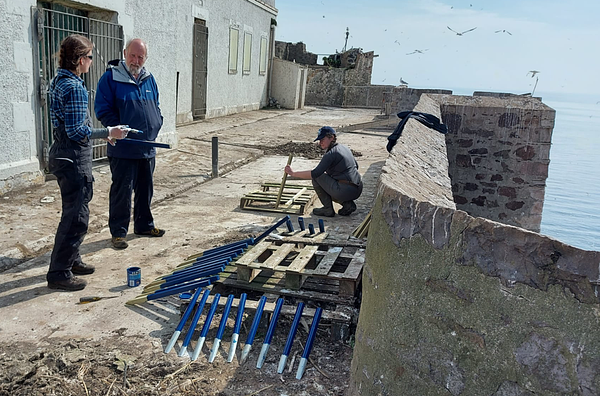
An hour later, we have dragged all the kit up to the steep granite slope of the Bass and into the breeding colony. We have attached 14 waterproof, miniature HOBO temperature loggers to numbered wooden poles and are hammering these into the ground with surprising ease. This makes me worry about the next rain and how long they’ll stay in their carefully calibrated southerly facing position, standing at a height of about 28 cm above ground level. There was a short-term disturbance of the nesting gannets as we approached, but we are purposefully early in the breeding season. This means that the gannets have not yet laid eggs, and once we retreat the pairs are quick to reclaim their chosen sites and resume their home building routines.
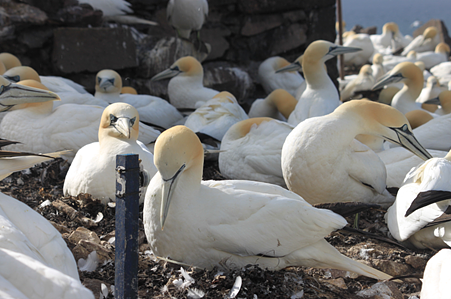
We then attempt a first data download. We programmed the HOBO loggers to take a temperature reading every 5 minutes. They can store data for up to 6 months, but to be safe, we will download the most recent data every time we visit the Bass Rock during the 2022 breeding season. The loggers establish a Bluetooth connection with an app on our mobile phone, and since our study site is quite small, it is possible to quietly sit at the fringe of the study site and download the first few data points – it’s great when field data collection is so straight forward!
The next few months will show that I needn’t have worried about the firmness of the attachment – the poles stay in place, most of the multiple cable ties holding the loggers in place last, and none of the loggers malfunctioned. When we retrieve the loggers in late September, we have collected around 96,000 temperature readings - novel data that will allow us to better understand the variation in ambient temperature at nest level that the gannets experience throughout a breeding season.
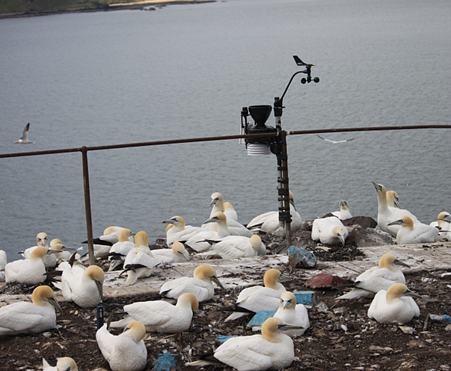
Ambient temperature is only one component of the microclimatic variation we are interested in. Our weather station will collect data on rain fall, humidity, air temperature, wind speed, wind direction and solar radiation. We attach the main sensor suite to the metal railing that runs along the concrete path leading past the medieval chapel ruins and towards the top of the Bass Rock. Most of the path network has become prime gannet breeding habitat, but this small part of accessible railing proves very useful to us. The weather station sends the data to a logger that is encased in a weatherproof box running on an integrated solar panel. Because the connection is wireless, we can attach the data logging box to the railing at the fringe of the colony, where we won’t have to disturb any breeding pairs when we download the data.
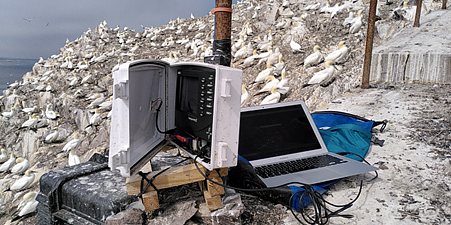
The final part of our microclimatic sensor suite is the Kestrel heat stress tracker, a handheld weather station, containing similar sensors to our large weather station, such as humidity and wind speed. We bought this as backup in case the main weather station fails, but it will also allow us to collect more than air temperature sensor data nearer to the gannet’s nests. Shannon will temporarily attach this instrument to wooden poles close to her study nests before she starts collecting thermal imaging and observational data. She will begin this work once the chicks have hatched, about 1.5 months after the installation of the original kit.
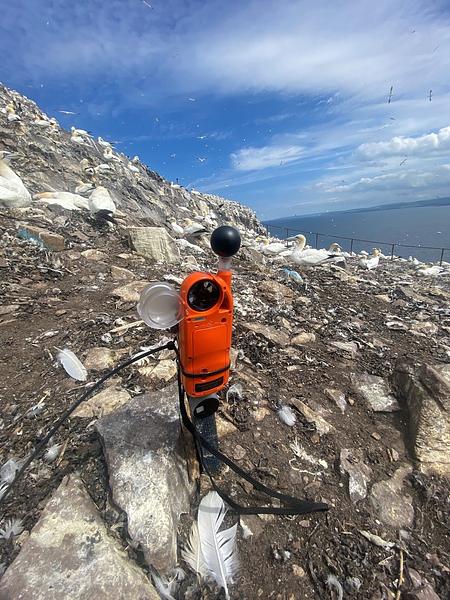
We are not the first ones collecting meteorological data on the Bass Rock. The Bass Rock Lighthouse, built in 1901 by David A Stevenson and only automated in 1988, had diligent keepers that very likely noted air temperature, rain fall and barometric pressure readings into their logbooks. Supported by the very helpful staff of the Northern Lighthouse board, I am hunting down these logbooks to see if we can make use of these long-term data, to set our measurements into context. Despite a clear overall trend, the warming of the climate is not a simple linear increase in air temperature. There are wriggles in the data, years of above average heat or below average cooler temperatures, extreme rainfall, and rows of years where the data looks very similar, flattening the curve. As scientists, we are interested in this variation.
We also need to put the thermal and observational data that we will collect in a broader context. This will allow us to understand if we are quantifying heat stress in gannets in a particularly hot year, or if 2022 was a year with average conditions. Short of the location specific data, we acquire long-term air temperature data from a Met Office weather station in Leuchars, starting in 1960. We calculate the anomaly – the positive or negative difference – of each year’s temperature compared to the baseline for which we take the average temperature over the first ten years. We illustrated these data as red (hotter than baseline) and blue (cooler than baseline) bars, one for each day spanning Shannon’s study period in June and early July. This visualization allows us to see very clearly that 2022 was very hot compared to previous years, that it has been getting warmer in recent decades, but that there is also a lot of variation between years.
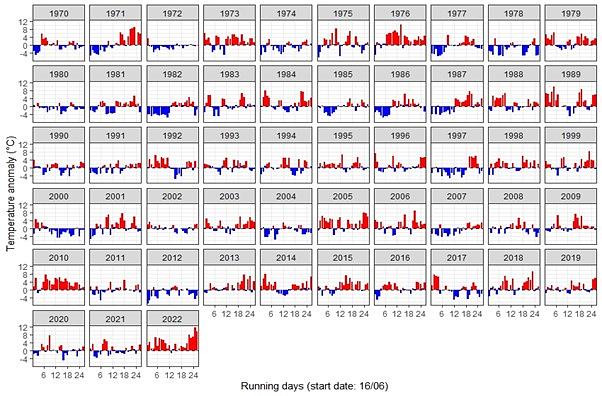
A long day on the Bass Rock, early in the breeding season when the colony is teeming with activity and noise, is ending. As I look back from the boat towards the towering rock, the noise recedes, and the circling gannets start resembling clouds of graceful white midges. I am happy because we have successfully completed our preparatory work and I think about the weeks and months ahead. We will have to wait until the eggs have hatched and we hope for a good season with many chicks and few nest failures, or equipment malfunction. I am excited because we will measure, for the first time, how Northern gannets, a temperate seabird species, respond to variation in their microclimatic environment and if they show signs of heat stress.
Read the next blog in this series to find out more about how heat impacts seabirds and how it can be measured HERE.
Acknowledgements:
We would like to thank Emily Burton and Susan Davies from the Scottish Seabird Centre for raising the funding for our equipment through the Nature Restoration Fund and for the enjoyable project partnership. We would like to thank Maggie Sheddan, Jack Dale and John McCarter for hugely appreciated logistical support and the friendly staff at Homes & Hardware for the supporting chats about tools. This research was funded by the Nature Restoration Fund, the University of Glasgow and the Glasgow Natural History Society.
- Header Image Copyright: Greg MacVean

